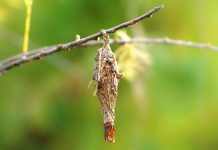Kallima inachus butterfly is found throughout tropical Asia from India to Japan. Where it is known by different names, i.e., orange oakleaf, Indian oakleaf, or dead leaf. Its closed wings resemble dried autumn leaves, giving it the greatest camouflage an insect could hope for. As soon as its wings are opened, they reveal a luminous color pattern that is equal to the prettiest wings in the world. It closely resembles a dry leaf with dark veins when its wings are closed, a form of camouflage commonly used by hunters.
There are only cryptic underside markings, consisting of irregular patterns and striations in many shades of biscuit, buff, brown, yellow, and black. These markings can be seen when the wings are closed. Veins are darkened and resemble leaf veins. Oakleaf, or dead leaf, is a common name for the genus because it is so resemblant to a dead leaf. There is no doubt that this butterfly is among the most beautiful insects in the world, called the “flying flower” and the “beauty of the insect kingdom.” Butterflies play both a prey and predator role in the food chain.

There is an orange discal band at the base of the forewing and a black apex with a deep blue apex when the wings are open. One white oculus lines the apical black band, while the other borders orange and deep blue areas. There are brown patches along the termen of the hindwing that are more uniform in shade than the forewing.
The female butterfly has a longer forewing apex than the male, and the apex of the forewing protrudes. Although smaller than the dry-season form, it is very similar to it. There is a richer and darker color scheme, and the orange discal band has a broader black border on the inner side. Some specimens from areas of heavy rainfall have dark ochraceous brown ground color on the underside.
India, Nepal, Bhutan, Bangladesh, and Myanmar, as well as Tenasserim Hills, is home to the orange oakleaf. Kallima inachus is also found in southern China, Thailand, Laos, Taiwan, and Vietnam in Southeast Asia. Moreover, this butterfly was also reported in Pakistan in 2000. It is common for tropical butterflies to be less active during the dry season. To hide from predators, they only need camouflage if they stay perfectly still.
In India, the butterfly is not rare, while in China, it is considered rare. Orange oakleaf reaches a height of 1,800 meters (5,900 ft) in the hills. The butterfly flies in dense forests with plenty of rainfall, amongst the undergrowth and along stream beds. It is attracted to tree sap and overripe fruit, as well as mud puddles. The orange oakleaf is often pursued by birds, but when in danger, it flies erratically, dropping down into the foliage and occupying a stationary pose with wings closed.

Therefore, birds are often unable to find it. This pose perfectly camouflages the butterfly as a dried leaf. Some bacteria, birds, ants, spiders, and wasps (including Trichogramma species) are natural enemies of the orange oakleaf. Consequently, much research has been done on breeding the butterfly in captivity in China.
A sequence of mitochondrial DNA was performed and found to contain 15,183 base pairs. Diapause research has also been conducted on butterflies. Multivoltine butterflies fly from April to October in the Himalayas. From April to December, Kehimkar (2009) recorded butterflies on the wing in India. Read More – 12 Images to Understand the Butterfly Life Cycle
Incredible camouflage of the Kallima inachus butterfly.pic.twitter.com/2CHYdYzOxx
— Fascinating (@fasc1nate) October 21, 2022






